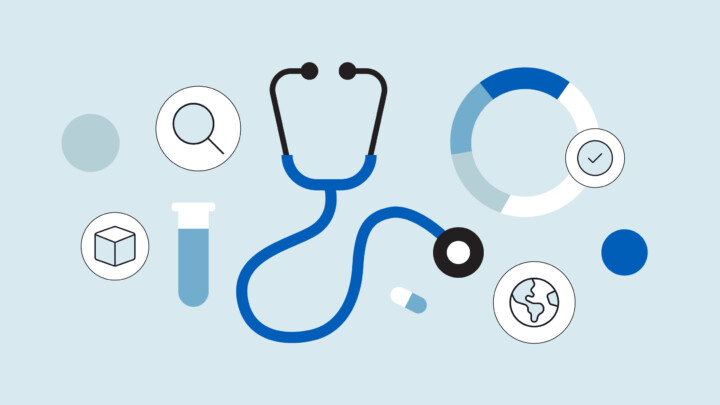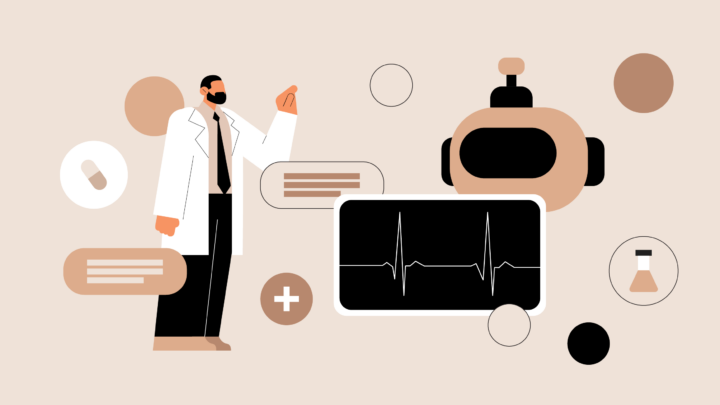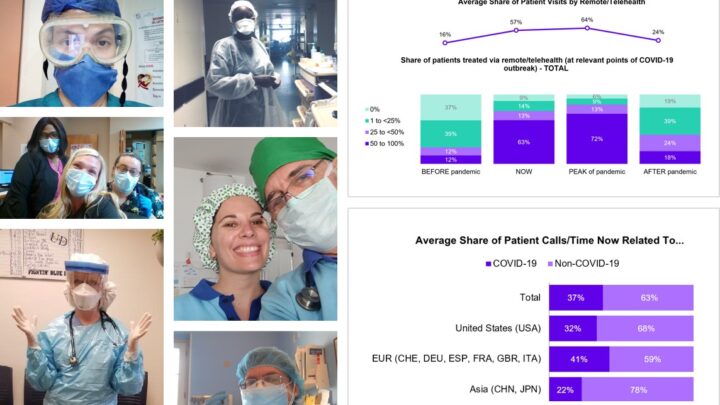
Healthcare has experienced significant shifts over the past few years, largely due to the rapid adoption of telemedicine. Accelerated by the COVID-19 pandemic, telemedicine has transformed healthcare delivery, making it faster, more accessible, and more adaptable. For physicians, this evolution has been both promising and daunting, as it requires learning new technologies, reshaping practices, and navigating a digital-first approach to patient care.
Inside the Sermo community, doctors shared their opinions on telemedicine, with 75% reporting they already use telemedicine in their practice to make their day-to-day workflows more efficient and creating space to refocus on mental health and schedule flexibility. For many who once felt burnt out in traditional settings, telemedicine provided a lifeline.
Emerging technologies like artificial intelligence, big data analytics, remote robotic surgery, and wearable tech are driving the next wave of changes in healthcare. But what do these advancements mean for physicians and patients alike? And which trends are set to define the future of telemedicine in 2025?
What is telemedicine technology
Telemedicine leverages secure digital platforms to deliver medical care and consultations remotely. It can involve video calls, phone calls, health data monitoring devices, and even robotic-assisted surgeries. These technologies make healthcare more accessible, especially for patients in rural areas or regions with limited resources.
For many, telemedicine is no longer an occasional option but an integral part of modern practice. “Telemedicine came during the pandemic to stay. In my workplace, not only are sophisticated devices of remote monitoring are common, but the use of the classic telephone to replace medical acts that until recently no one considered in a non-face-to-face manner” a physician wrote on Sermo. Now, remote monitoring devices and even simple tools like telephone-based consultations have become essential in everyday clinical workflows.
How it works
Telemedicine operates through a combination of real-time communication, data sharing, and remote patient monitoring. For instance, a physician can remotely track a patient’s heart rate using wearable devices and adjust treatment plans accordingly without an in-person visit. Telemedicine extends the reach of specialists to underserved areas, ensuring more patients have access to quality care.
A physician on Sermo shared how telemedicine helped him to reclaim his schedule and heal from burnout. “I started my medical career at the Emergency Dept. I was working at a busy, high volume/acuity ED for 10+ yrs. Then Covid hit and telemedicine grew exponentially.”
“Pre-Covid, there were already telemedicine practices (teledoc, Amwell, etc.) in its nascent stage…I was already getting burned out from the Emergency Dept after 10 yrs and Telemedicine provided an opportunity to cut down from the ED. Of course the compensation was less but my mental health was so much better. Further, the flexibility was a welcomed addition…I have not worked a shift in the Emergency Department in 3 yrs. I never thought this would be the case when I started my ED career in 2011.” he recounted.
Telehealth vs. telemedicine
While telemedicine and telehealth are frequently used interchangeably, they are not the same. Telehealth encompasses a broader spectrum of healthcare services, including clinical and non-clinical activities such as training healthcare workers, conducting administrative meetings, and patient education.
Telemedicine, on the other hand, is a subset of telehealth that specifically deals with providing remote clinical services. For example, diagnosing a skin condition during a video consultation with a dermatologist falls under telemedicine, whereas using an app to schedule patient appointments falls under telehealth.
Understanding this distinction is crucial for healthcare professionals and policymakers as these terms often have differing legal, billing, and operational implications.
Future of telemedicine systems: 20 trends shaping healthcare in 2025
The telemedicine industry shows no signs of slowing down. It’s no surprise then, that 87% of physicians in the Sermo community said they believed the use of telehealth in healthcare will continue to increase. Recent medical tech advancements are set to revolutionize the way physicians diagnose, treat, and monitor patients. Below, we explore the most impactful trends defining telemedicine’s future in 2025.
AI-powered diagnostics
Artificial intelligence is supercharging diagnostic capabilities. Algorithms can analyze CT scans, X-rays, and other diagnostic imaging with speed and accuracy that rival human interpretation, allowing for earlier disease detection and personalized treatment plans. For example, AI tools are already helping radiologists detect anomalies that might otherwise go unnoticed.
Many physicians are hopeful that AI will alleviate burnout by replacing routine tasks. 78% of Sermo survey respondents expressed optimism that AI could improve clinic efficiency by reducing time spent on documentation and non-clinical duties.
Remote patient monitoring expansion
Remote Patient Monitoring (RPM) continues to grow, enabling physicians to track vital signs like blood pressure, glucose levels, and oxygen saturation in real time. This proactive model allows for earlier intervention, improved chronic condition management, and fewer hospital readmissions.
Wearable health technology integrations
Wearables like smartwatches and fitness trackers are more than just trendy gadgets; they deliver crucial health data directly to healthcare providers. These integrations enable the continuous monitoring of patients with conditions such as diabetes or atrial fibrillation, leading to more tailored care plans and empowering patients to take significant steps in preventive care.
Virtual reality for therapy and training
Virtual Reality (VR) is changing the way therapy and medical training are delivered. From helping patients manage PTSD and chronic pain to training surgeons in simulated environments, VR is proving to be more than just a tool for gaming.
Augmented reality for remote surgeries
Augmented Reality (AR) enables surgeons to perform complex procedures remotely. By overlaying real-time imaging with patient anatomy, AR guides physicians during robotic-assisted surgeries, pushing the boundaries of what’s possible in the operating room.
Blockchain for secure patient data
With the rise of digital healthcare comes the challenge of data security. Blockchain technology ensures encryptions in patient data, safeguarding sensitive information and fostering trust between doctors and patients.
5G-enhanced telehealth connectivity
Ultra-fast 5G connections eliminate lag during video consultations and enable data transfers for high-resolution imaging, making telemedicine seamless for both providers and patients.
Personalized medicine via big data analytics
Using big data, physicians can identify patterns in patient populations, predict treatment outcomes more accurately, and provide care tailored to individual needs. This approach bridges the gap between evidence-based medicine and personalized care.
Voice-activated AI assistants in telemedicine
AI-driven voice assistants support physicians by taking notes during consultations, suggesting follow-up actions, and even helping schedule future appointments.
Digital therapeutics and app-based treatments
Specialized apps now provide therapy for mental health issues, diabetes management, and more, enabling physicians to offer round-the-clock care through non-traditional channels. A growing number of health and longevity apps are available, with 94% of physicians on Sermo agreeing that mobile app technology can help improve patient outcomes.
Increased telepsychiatry adoption
The stigma surrounding mental health is being reduced, thanks to telepsychiatry. This model connects patients with mental health professionals in a convenient and private way, removing obstacles such as travel and waiting times.
Expansion of hospital at home models
Hospital at Home programs, where acute care is delivered in a patient’s home, are expanding rapidly. They provide a safer and more comfortable environment for recovery, particularly during pandemics or emergencies.
Cross-border telemedicine services
The future of telemedicine transcends borders. Physicians can consult with patients and specialists worldwide, ensuring access to healthcare regardless of geographic or political boundaries.
Interoperability improvements for EHR integration
Enhanced interoperability between Electronic Health Records (EHR) systems facilitates smoother data sharing between healthcare providers, removing data siloes and optimizing patient outcomes through the internet of things (iot) and secure software application programming interfaces (API).
Remote robotic-assisted procedures
Highly precise robotic systems are enabling surgeries to be performed remotely by specialists across the globe. This technology breaks down both geographic and expertise barriers.
AI-driven chatbots for preliminary consultations
Admin work and pre-consultation paperwork often steal physicians’ valuable time with patients. AI chatbots can handle initial patient interactions, collect symptoms, and triage queries before patients arrive, reducing physician workload without compromising care quality.
Hybrid telehealth and in-person care models
Rather than replacing in-person care, telemedicine is evolving to complement it. Hybrid models blend digital and face-to-face consultations to provide seamless and comprehensive patient experiences.
Enhanced cybersecurity measures for patient data
With the increasing digitization of healthcare, cybersecurity is more important than ever. Enhanced measures are required to protect sensitive data, ensuring patient confidentiality remains a priority.
Insurance and reimbursement policy evolution
With the exponential rise in use, more insurers are acknowledging telemedicine’s role and expanding reimbursement policies to reflect its growing importance in healthcare delivery.
Greater regulatory acceptance of digital healthcare
Governments and regulatory bodies worldwide are now recognizing the potential of telemedicine to improve healthcare access and outcomes, leading to more favorable policies and standards.
How these telemedicine trends impact physicians
In the midst of all of these new technological advances, it is paramount that healthcare leaders remember the core foundations of solid patient-centered practice. A doctor on Sermo stated, “Fortunately, in terms of medical technology we are growing by leaps and bounds, I only hope that it will never replace an excellent and thorough history and physical examination, always for the highest good of the patient, as well as always ensuring an excellent doctor-patient relationship and communication, in short, that it adds and not subtracts from great clinical practice.”
Among these trends, AI-powered diagnostics and hybrid care models stand out as game changers for physician workflows. By automating repetitive tasks and enabling seamless integration of digital and in-person consultations, they free up physicians’ time to focus on what matters most – patient care.
On Sermo, physicians discuss these emerging changes, exchange experiences, and brainstorm solutions to technical and ethical challenges posed by telemedicine. Harness the power of peer collaboration – Join Sermo today to connect with a global community of healthcare professionals.
People also ask
AI in telemedicine will revolutionize diagnostics, pre-consultation admin, patient monitoring, and treatment plans, enhancing efficiency and personalized care through advanced telemedicine technology and telemedicine systems.
The biggest challenge in telehealth is ensuring secure patient data and interoperability improvements for EHR integration, which can be addressed through enhanced cybersecurity measures and blockchain technology in future telemedicine systems.
As one emergency medicine physician discussed on Sermo, “Digital health is very useful, although I think we still have a long way to go on this issue, especially in underdeveloped countries. I consider this platform an example of digital health because it allows us professionals to foster exchange relationships, socialization of experiences and knowledge that contribute to professional training and better medical care.”
The future of the Internet of Medical Things (IoMT) will enhance remote patient monitoring, improve telemedicine technology, and create interconnected telemedicine systems for seamless healthcare data exchange and real-time health tracking.
Telemedicine has historical roots dating back to the early 20th century with the use of telephone consultations, but it has rapidly evolved with advances in telemedicine technology and telemedicine systems to become a cornerstone of modern healthcare.















